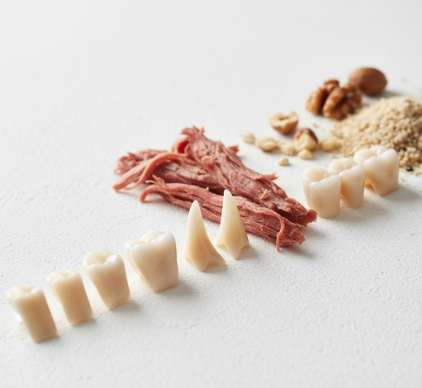Ever paused mid-bite and wondered why your mouth isn’t just equipped with a single type of tooth, all lined up like identical pegs? It might seem simpler, but nature, in its wisdom, opted for variety. Think of your mouth as a highly efficient food processing plant, and your teeth as specialized tools, each designed for a specific task in breaking down what you eat. This diversity isn’t just for show; it’s absolutely crucial for tackling the vast array of textures and consistencies found in our diets, from a crisp apple to a chewy piece of bread or a tender steak. Without this dental toolkit, enjoying – and properly digesting – our meals would be a far more challenging, if not impossible, endeavor.
The journey food takes from your plate to your stomach begins with these remarkable structures. Each type of tooth plays a distinct role in the mechanical breakdown of food, a process vital for releasing nutrients and preparing the food for the next stages of digestion. So, let’s delve into the fascinating world within our mouths and explore why having different types of teeth is fundamental to our ability to eat effectively and enjoy the rich tapestry of human cuisine.
The Cutting Edge: Meet Your Incisors
Positioned right at the front and center of your smile are the
incisors. You have eight of these in total – four on the top jaw and four on the bottom. Their name comes from the Latin word ‘incidere,’ which means ‘to cut,’ and that’s precisely their primary job. Think of them as your mouth’s built-in scissors or precision knives. They are relatively thin and flat, with a somewhat spade-like shape and a sharp, straight biting edge.
When you bite into an apple, a carrot stick, or a sandwich, your incisors are the first teeth to engage. They are perfectly designed to snip off manageable pieces of food from a larger whole. Their sharpness allows for a clean cut, preventing you from having to tear or awkwardly rip at your food initially. Imagine trying to take a neat bite out of a crisp lettuce leaf without them; it would be a messy affair! Beyond just cutting, incisors also play a role in sensing the texture and hardness of food items before you commit to a full chew. They provide that initial feedback, helping you gauge how much effort the rest of your teeth will need to put in.
While they are excellent at initiating the eating process, their relatively delicate structure means they aren’t designed for heavy-duty grinding or tearing. That’s where their dental colleagues come into play. But without the incisors making that first crucial cut, the rest of the team would have a much harder job.
The Grippers and Tearing Titans: Your Canines
Nestled at the corners of your dental arches, just beyond the incisors, are the
canines. You have four of these formidable teeth, two in the upper jaw and two in the lower. They are easily recognizable by their distinctively pointed, conical shape. In fact, they are typically the longest teeth in the human mouth, with a single, sharp cusp designed for a very specific and vital purpose: gripping and tearing food.
If incisors are the scissors, then canines are the anchors or small, sharp daggers. Their primary function is to pierce into tougher foods and hold them securely while you tear off a piece. Think about eating foods like meat, tough bread crusts, or even some fibrous vegetables. The canines sink in, providing the leverage needed to rip these items apart into smaller, more manageable chunks that can then be passed back to the other teeth for further processing. Their strong, long roots, firmly embedded in the jawbone, give them the stability required for this demanding task.
While human canines are not as pronounced as those found in dedicated carnivores (like lions or wolves, whose canines are crucial for hunting and dispatching prey), they still play a significant role in an omnivorous diet. They bridge the gap between the cutting action of the incisors and the grinding action of the teeth further back. Without canines, dealing with anything requiring a firm grip and a good tear would be considerably more difficult, likely leading to less efficient chewing and perhaps even a reluctance to tackle certain food textures.
The Dual-Action Specialists: Introducing Premolars
Moving further back into the mouth, behind the canines, you’ll find the
premolars, also sometimes known as bicuspids. Adults typically have eight premolars, four in the upper jaw and four in the lower, with two on each side. These teeth serve as a crucial transition team, bridging the gap in function between the tearing canines at the front and the heavy-duty grinding molars at the back.
Premolars are larger and stronger than incisors and canines but smaller than molars. Their shape reflects their dual role. They usually have two pointed cusps on their biting surface (hence the name ‘bicuspid,’ though some lower premolars can have one or three), which makes them versatile. These cusps allow them to participate in some tearing of food, but their flatter surfaces also enable them to begin the process of crushing and grinding. They are like the apprentices to the master grinders, the molars, helping to break down food into smaller particles before it reaches the back of the mouth.
When you chew, food is often moved by your tongue from the front of your mouth to these premolars. Here, they take over from the canines, further mashing and breaking down pieces that have already been cut or torn. Think of them as tenderizers, working on food that needs a bit more persuasion before it’s ready for the final, thorough grinding phase. They are particularly effective for foods that are somewhat tough but don’t require the full force of the molars, like certain fruits, vegetables, and softer meats.
The Mighty Grinders: Your Molars
At the very back of your mouth reside the largest and strongest teeth: the
molars. Their name is derived from the Latin word ‘molaris,’ meaning ‘millstone,’ which perfectly describes their primary function. Adult humans can have up to twelve molars, including the four wisdom teeth (or third molars), though many people have their wisdom teeth removed or they may not erupt at all. Typically, you’ll have three molars on each side of both your upper and lower jaws, making them the workhorses of your dental lineup.
Molars are characterized by their broad, relatively flat biting surfaces, which feature multiple rounded cusps. These cusps and the grooves between them create an ideal terrain for the serious business of grinding, crushing, and mashing food into a fine pulp. When food reaches the molars, it has already been cut by incisors, possibly torn by canines, and partially broken down by premolars. The molars then take over for the final, intensive stage of mechanical digestion in the mouth.
Their substantial size and multiple roots anchor them firmly in the jaw, allowing them to withstand the significant forces generated during chewing. Imagine trying to eat grains, nuts, or fibrous plant material without these powerful grinders. It would be incredibly difficult to break these foods down sufficiently for safe swallowing and efficient digestion. The thorough pulverization performed by the molars dramatically increases the surface area of the food, making it much easier for digestive enzymes in the stomach and intestines to access and break down nutrients. Without effective molar action, digestion would be less efficient, and you might not get the full nutritional benefit from your food.
Human dentition showcases remarkable adaptation. Typically, adults possess 32 permanent teeth, meticulously designed for an omnivorous diet. This set includes 8 incisors for cutting, 4 canines for tearing, 8 premolars for initial crushing, and 12 molars (including wisdom teeth) for thorough grinding. Each type’s unique structure is crucial for processing a diverse range of food textures efficiently.
A Coordinated Effort: The Teamwork of Teeth
Having different types of teeth is only part of the story; their true genius lies in how they work together in a beautifully coordinated sequence. Eating isn’t just about individual teeth doing their jobs in isolation; it’s a dynamic process, a symphony of precise movements and collaborative effort involving your teeth, tongue, jaw, and saliva.
The process typically begins with your
incisors taking the first bite, neatly snipping off a manageable portion of food. If the food is particularly tough or requires a firm grip – say, a piece of jerky or a fibrous fruit – your
canines will engage, piercing and tearing it. Once the food is in your mouth, your tongue plays a crucial role, skillfully maneuvering the bolus (the technical term for that chewed-up ball of food) towards the
premolars. These transitional teeth begin the crushing and grinding, breaking the food down further.
Finally, the tongue pushes the partially processed food back to the
molars. Here, with the powerful support of your jaw muscles, the real grinding takes place. The broad surfaces of the molars work like millstones, pulverizing the food into a soft, moist pulp that’s easy to swallow and ready for chemical digestion in your stomach. Throughout this entire process, saliva is constantly being mixed with the food, moistening it, aiding in the formation of the bolus, and beginning the breakdown of carbohydrates with its enzymes.
This intricate teamwork ensures that food is broken down efficiently and effectively. Each tooth type performing its specialized role makes the entire process smoother and more complete than if we had only one type of tooth. This specialization is a hallmark of an omnivorous diet, allowing us to tackle everything from soft fruits to hard nuts and tough meats with equal proficiency. It’s a testament to the incredible design inherent in our anatomy.
The Evolutionary Advantage: Teeth for Every Occasion
The reason we possess this diverse array of dental tools – incisors, canines, premolars, and molars – boils down to one fundamental aspect of human existence: our incredibly varied, omnivorous diet. Unlike specialized animals, such as herbivores with predominantly flat grinding teeth for plant matter, or carnivores with sharp, blade-like teeth for slicing flesh, humans have evolved to consume a bit of everything. Our teeth reflect this dietary flexibility.
Imagine trying to eat a steak with teeth designed only for grinding grains, like those of a cow. It would be an exercise in frustration. Conversely, picture trying to process tough plant fibers with only sharp, tearing teeth. You wouldn’t be able to break down the cellulose effectively. Our dental toolkit provides the versatility needed to handle the diverse textures and structures found in fruits, vegetables, grains, nuts, seeds, and meats.
The incisors give us the finesse to bite into delicate items and the initial cutting power for more robust ones. The canines provide the strength to tear into resistant foods. The premolars offer a transitional stage, capable of both some tearing and initial crushing. And the molars deliver the sheer grinding force necessary to pulverize food, making it ready for digestion and nutrient absorption. This division of labor is not just convenient; it’s essential for extracting the maximum nutritional value from the wide spectrum of foods available to us.
This ability to process a wide range of food sources has been a significant evolutionary advantage, allowing humans to thrive in diverse environments and adapt to different food availabilities. So, the next time you enjoy a meal, take a moment to appreciate the intricate design of your dental team. They are a testament to nature’s ingenuity, perfectly equipping you for the culinary adventures that make up your daily life.









